Management Accounting Report: Cost Analysis, Budgeting, and Variances
VerifiedAdded on 2020/01/28
|20
|5348
|89
Report
AI Summary
This management accounting report provides a comprehensive analysis of cost accounting principles applied to Jeffrey & Son's. The report begins with a classification of costs based on element, nature, function, and behavior. It then computes the unit cost for Job no. 444 using the job costing method and determines the cost of the Exquisite product using absorption costing. The report includes an analysis of cost data using appropriate techniques, followed by the preparation of a cost report for September, including variance analysis. The report also discusses indicators for identifying areas for potential improvement and ways to reduce costs while improving quality and enhancing value. Additionally, the report covers budgeting processes, including production, material purchase, and cash budgets. Finally, it computes variances, identifies possible causes, recommends corrective actions, and presents an operating statement with a discussion on responsibility centers. The analysis highlights the importance of effective cost management for business performance and profitability.
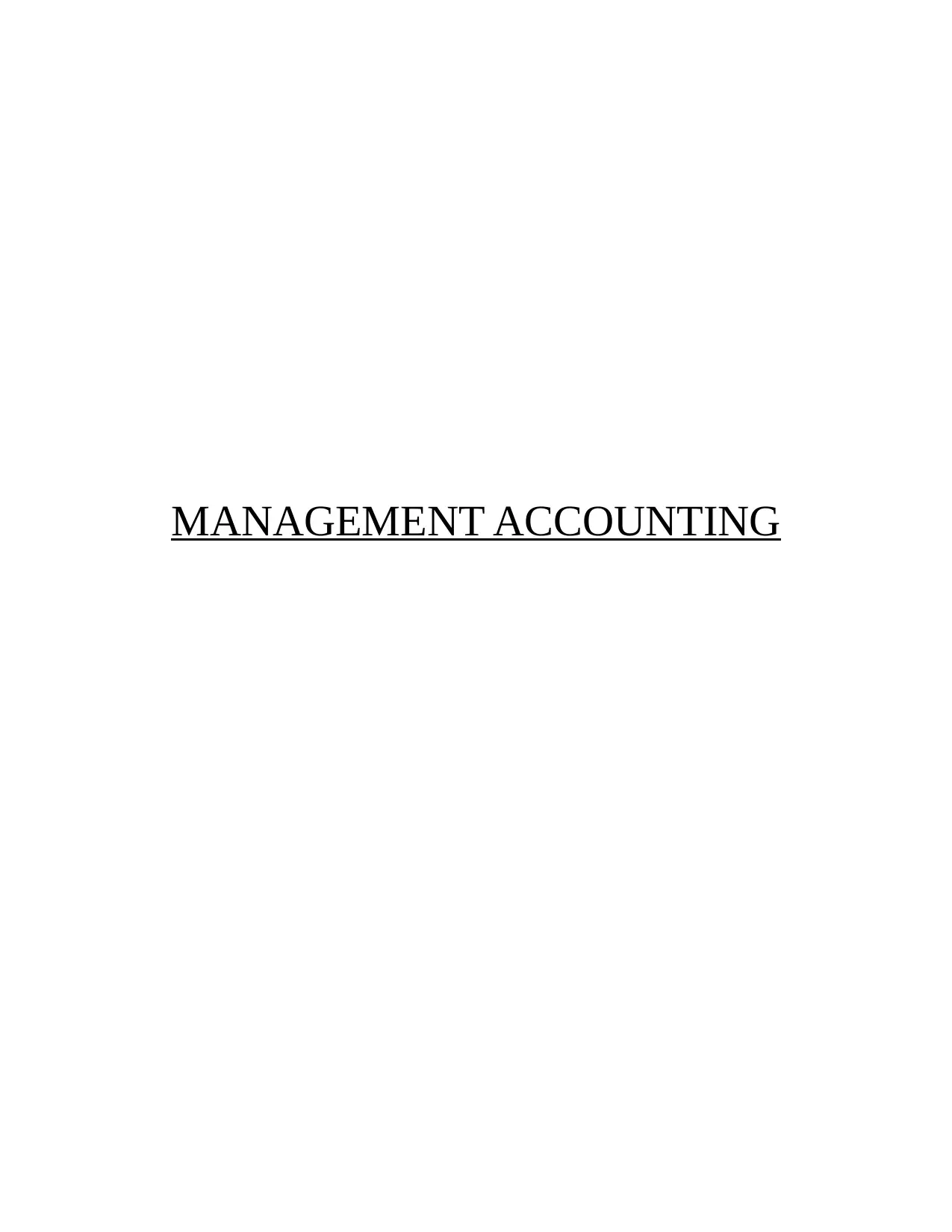
MANAGEMENT ACCOUNTING
Paraphrase This Document
Need a fresh take? Get an instant paraphrase of this document with our AI Paraphraser
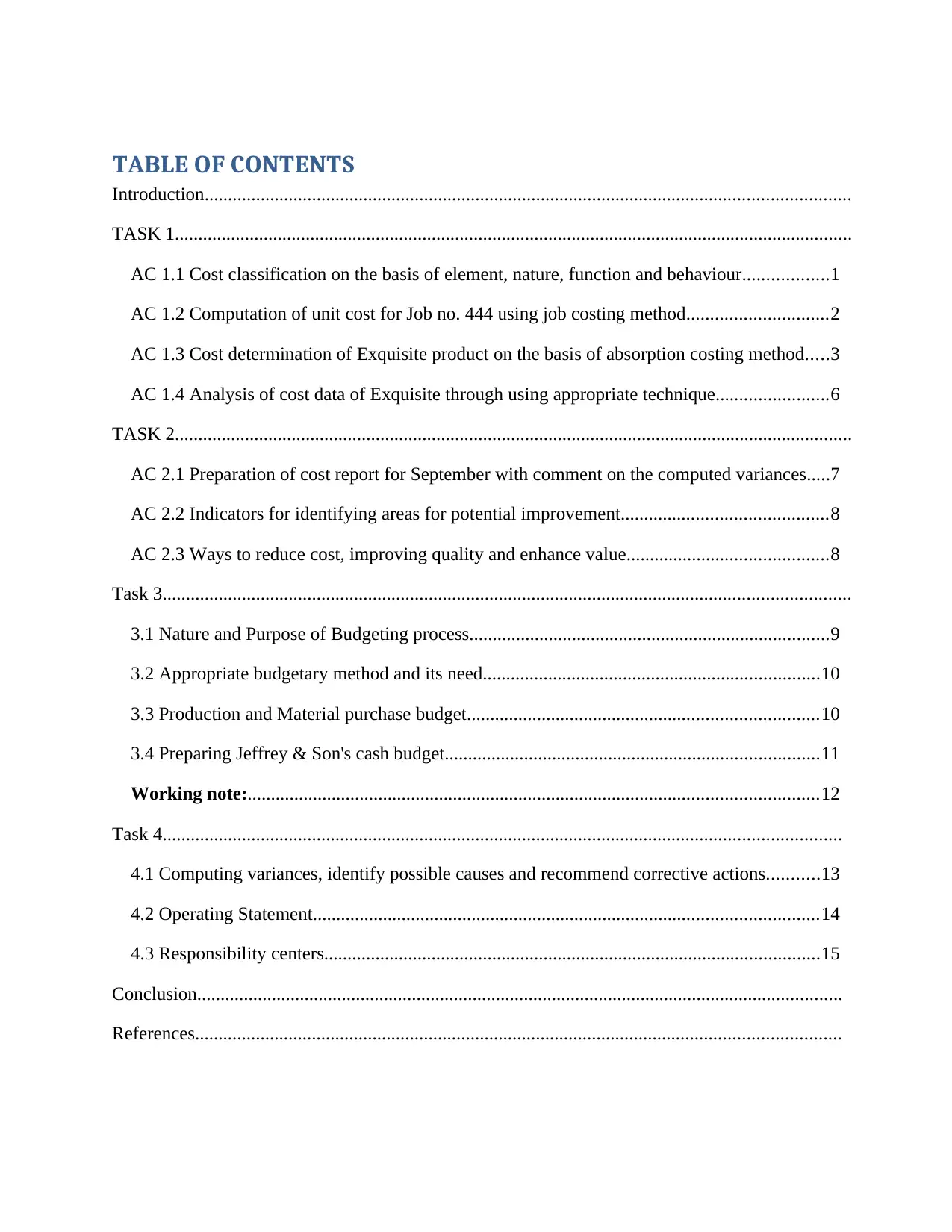
TABLE OF CONTENTS
Introduction..........................................................................................................................................
TASK 1.................................................................................................................................................
AC 1.1 Cost classification on the basis of element, nature, function and behaviour..................1
AC 1.2 Computation of unit cost for Job no. 444 using job costing method..............................2
AC 1.3 Cost determination of Exquisite product on the basis of absorption costing method.....3
AC 1.4 Analysis of cost data of Exquisite through using appropriate technique........................6
TASK 2.................................................................................................................................................
AC 2.1 Preparation of cost report for September with comment on the computed variances.....7
AC 2.2 Indicators for identifying areas for potential improvement............................................8
AC 2.3 Ways to reduce cost, improving quality and enhance value...........................................8
Task 3...................................................................................................................................................
3.1 Nature and Purpose of Budgeting process.............................................................................9
3.2 Appropriate budgetary method and its need........................................................................10
3.3 Production and Material purchase budget...........................................................................10
3.4 Preparing Jeffrey & Son's cash budget................................................................................11
Working note:..........................................................................................................................12
Task 4.................................................................................................................................................
4.1 Computing variances, identify possible causes and recommend corrective actions...........13
4.2 Operating Statement............................................................................................................14
4.3 Responsibility centers..........................................................................................................15
Conclusion..........................................................................................................................................
References..........................................................................................................................................
Introduction..........................................................................................................................................
TASK 1.................................................................................................................................................
AC 1.1 Cost classification on the basis of element, nature, function and behaviour..................1
AC 1.2 Computation of unit cost for Job no. 444 using job costing method..............................2
AC 1.3 Cost determination of Exquisite product on the basis of absorption costing method.....3
AC 1.4 Analysis of cost data of Exquisite through using appropriate technique........................6
TASK 2.................................................................................................................................................
AC 2.1 Preparation of cost report for September with comment on the computed variances.....7
AC 2.2 Indicators for identifying areas for potential improvement............................................8
AC 2.3 Ways to reduce cost, improving quality and enhance value...........................................8
Task 3...................................................................................................................................................
3.1 Nature and Purpose of Budgeting process.............................................................................9
3.2 Appropriate budgetary method and its need........................................................................10
3.3 Production and Material purchase budget...........................................................................10
3.4 Preparing Jeffrey & Son's cash budget................................................................................11
Working note:..........................................................................................................................12
Task 4.................................................................................................................................................
4.1 Computing variances, identify possible causes and recommend corrective actions...........13
4.2 Operating Statement............................................................................................................14
4.3 Responsibility centers..........................................................................................................15
Conclusion..........................................................................................................................................
References..........................................................................................................................................
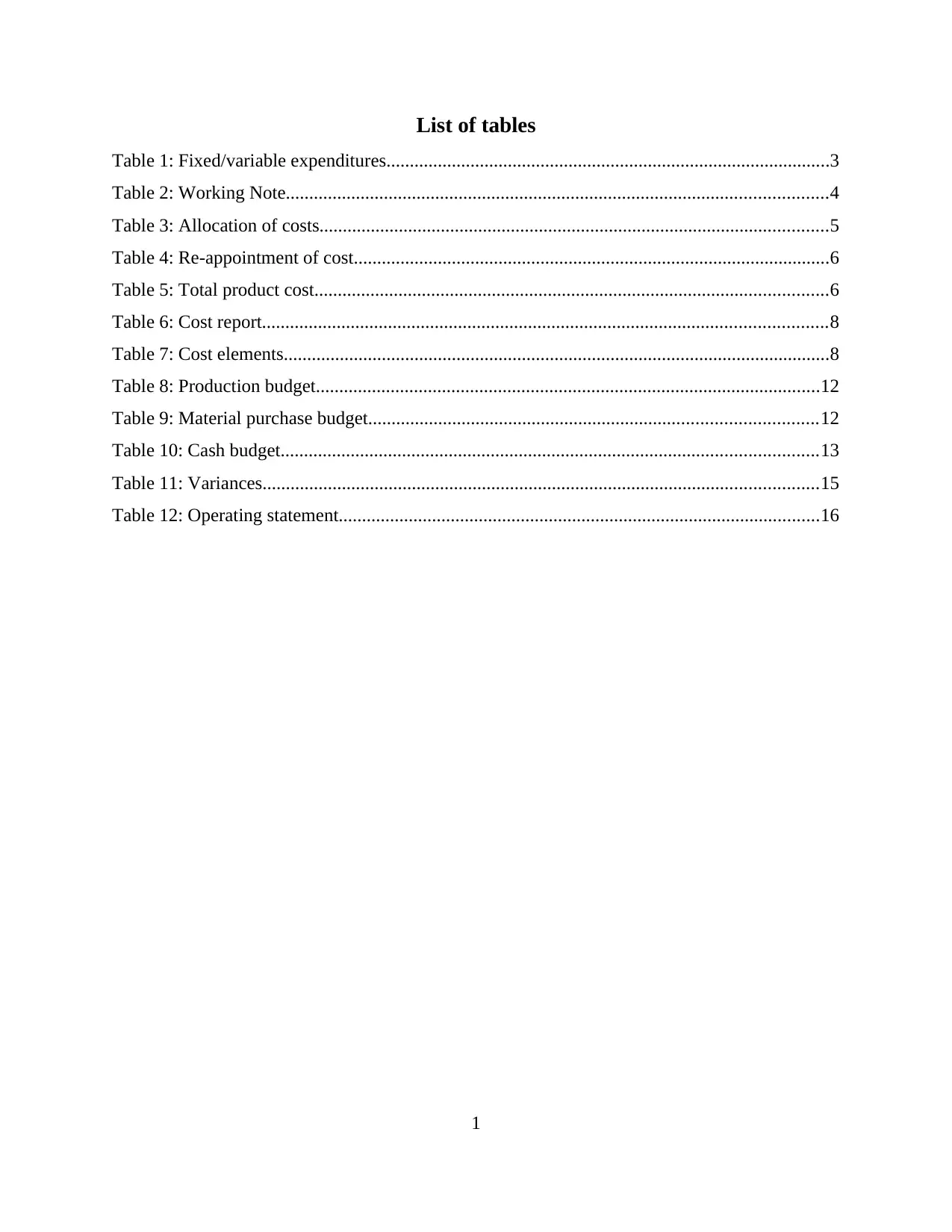
List of tables
Table 1: Fixed/variable expenditures...............................................................................................3
Table 2: Working Note....................................................................................................................4
Table 3: Allocation of costs.............................................................................................................5
Table 4: Re-appointment of cost......................................................................................................6
Table 5: Total product cost..............................................................................................................6
Table 6: Cost report.........................................................................................................................8
Table 7: Cost elements.....................................................................................................................8
Table 8: Production budget............................................................................................................12
Table 9: Material purchase budget................................................................................................12
Table 10: Cash budget...................................................................................................................13
Table 11: Variances.......................................................................................................................15
Table 12: Operating statement.......................................................................................................16
1
Table 1: Fixed/variable expenditures...............................................................................................3
Table 2: Working Note....................................................................................................................4
Table 3: Allocation of costs.............................................................................................................5
Table 4: Re-appointment of cost......................................................................................................6
Table 5: Total product cost..............................................................................................................6
Table 6: Cost report.........................................................................................................................8
Table 7: Cost elements.....................................................................................................................8
Table 8: Production budget............................................................................................................12
Table 9: Material purchase budget................................................................................................12
Table 10: Cash budget...................................................................................................................13
Table 11: Variances.......................................................................................................................15
Table 12: Operating statement.......................................................................................................16
1
⊘ This is a preview!⊘
Do you want full access?
Subscribe today to unlock all pages.

Trusted by 1+ million students worldwide
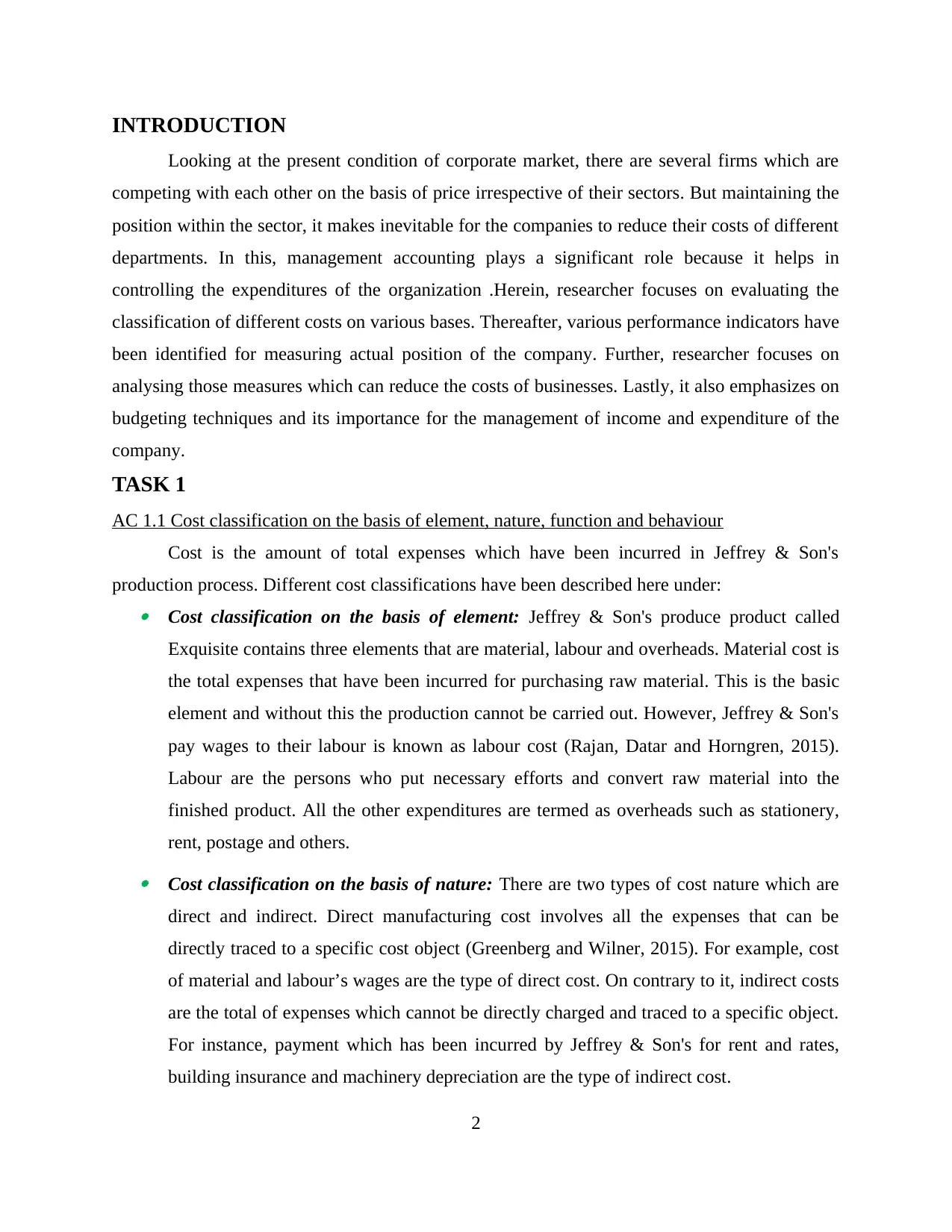
INTRODUCTION
Looking at the present condition of corporate market, there are several firms which are
competing with each other on the basis of price irrespective of their sectors. But maintaining the
position within the sector, it makes inevitable for the companies to reduce their costs of different
departments. In this, management accounting plays a significant role because it helps in
controlling the expenditures of the organization .Herein, researcher focuses on evaluating the
classification of different costs on various bases. Thereafter, various performance indicators have
been identified for measuring actual position of the company. Further, researcher focuses on
analysing those measures which can reduce the costs of businesses. Lastly, it also emphasizes on
budgeting techniques and its importance for the management of income and expenditure of the
company.
TASK 1
AC 1.1 Cost classification on the basis of element, nature, function and behaviour
Cost is the amount of total expenses which have been incurred in Jeffrey & Son's
production process. Different cost classifications have been described here under: Cost classification on the basis of element: Jeffrey & Son's produce product called
Exquisite contains three elements that are material, labour and overheads. Material cost is
the total expenses that have been incurred for purchasing raw material. This is the basic
element and without this the production cannot be carried out. However, Jeffrey & Son's
pay wages to their labour is known as labour cost (Rajan, Datar and Horngren, 2015).
Labour are the persons who put necessary efforts and convert raw material into the
finished product. All the other expenditures are termed as overheads such as stationery,
rent, postage and others. Cost classification on the basis of nature: There are two types of cost nature which are
direct and indirect. Direct manufacturing cost involves all the expenses that can be
directly traced to a specific cost object (Greenberg and Wilner, 2015). For example, cost
of material and labour’s wages are the type of direct cost. On contrary to it, indirect costs
are the total of expenses which cannot be directly charged and traced to a specific object.
For instance, payment which has been incurred by Jeffrey & Son's for rent and rates,
building insurance and machinery depreciation are the type of indirect cost.
2
Looking at the present condition of corporate market, there are several firms which are
competing with each other on the basis of price irrespective of their sectors. But maintaining the
position within the sector, it makes inevitable for the companies to reduce their costs of different
departments. In this, management accounting plays a significant role because it helps in
controlling the expenditures of the organization .Herein, researcher focuses on evaluating the
classification of different costs on various bases. Thereafter, various performance indicators have
been identified for measuring actual position of the company. Further, researcher focuses on
analysing those measures which can reduce the costs of businesses. Lastly, it also emphasizes on
budgeting techniques and its importance for the management of income and expenditure of the
company.
TASK 1
AC 1.1 Cost classification on the basis of element, nature, function and behaviour
Cost is the amount of total expenses which have been incurred in Jeffrey & Son's
production process. Different cost classifications have been described here under: Cost classification on the basis of element: Jeffrey & Son's produce product called
Exquisite contains three elements that are material, labour and overheads. Material cost is
the total expenses that have been incurred for purchasing raw material. This is the basic
element and without this the production cannot be carried out. However, Jeffrey & Son's
pay wages to their labour is known as labour cost (Rajan, Datar and Horngren, 2015).
Labour are the persons who put necessary efforts and convert raw material into the
finished product. All the other expenditures are termed as overheads such as stationery,
rent, postage and others. Cost classification on the basis of nature: There are two types of cost nature which are
direct and indirect. Direct manufacturing cost involves all the expenses that can be
directly traced to a specific cost object (Greenberg and Wilner, 2015). For example, cost
of material and labour’s wages are the type of direct cost. On contrary to it, indirect costs
are the total of expenses which cannot be directly charged and traced to a specific object.
For instance, payment which has been incurred by Jeffrey & Son's for rent and rates,
building insurance and machinery depreciation are the type of indirect cost.
2
Paraphrase This Document
Need a fresh take? Get an instant paraphrase of this document with our AI Paraphraser
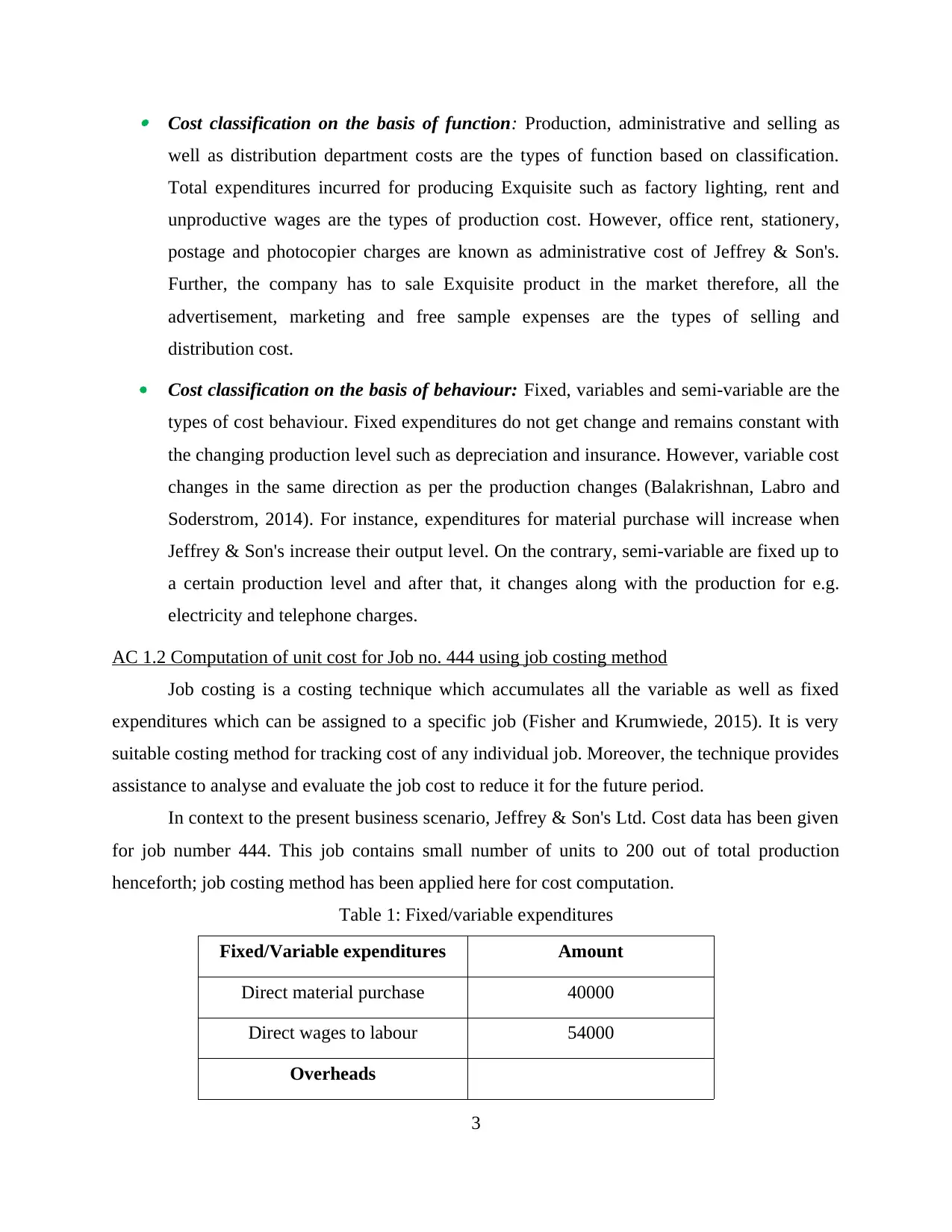
Cost classification on the basis of function: Production, administrative and selling as
well as distribution department costs are the types of function based on classification.
Total expenditures incurred for producing Exquisite such as factory lighting, rent and
unproductive wages are the types of production cost. However, office rent, stationery,
postage and photocopier charges are known as administrative cost of Jeffrey & Son's.
Further, the company has to sale Exquisite product in the market therefore, all the
advertisement, marketing and free sample expenses are the types of selling and
distribution cost.
Cost classification on the basis of behaviour: Fixed, variables and semi-variable are the
types of cost behaviour. Fixed expenditures do not get change and remains constant with
the changing production level such as depreciation and insurance. However, variable cost
changes in the same direction as per the production changes (Balakrishnan, Labro and
Soderstrom, 2014). For instance, expenditures for material purchase will increase when
Jeffrey & Son's increase their output level. On the contrary, semi-variable are fixed up to
a certain production level and after that, it changes along with the production for e.g.
electricity and telephone charges.
AC 1.2 Computation of unit cost for Job no. 444 using job costing method
Job costing is a costing technique which accumulates all the variable as well as fixed
expenditures which can be assigned to a specific job (Fisher and Krumwiede, 2015). It is very
suitable costing method for tracking cost of any individual job. Moreover, the technique provides
assistance to analyse and evaluate the job cost to reduce it for the future period.
In context to the present business scenario, Jeffrey & Son's Ltd. Cost data has been given
for job number 444. This job contains small number of units to 200 out of total production
henceforth; job costing method has been applied here for cost computation.
Table 1: Fixed/variable expenditures
Fixed/Variable expenditures Amount
Direct material purchase 40000
Direct wages to labour 54000
Overheads
3
well as distribution department costs are the types of function based on classification.
Total expenditures incurred for producing Exquisite such as factory lighting, rent and
unproductive wages are the types of production cost. However, office rent, stationery,
postage and photocopier charges are known as administrative cost of Jeffrey & Son's.
Further, the company has to sale Exquisite product in the market therefore, all the
advertisement, marketing and free sample expenses are the types of selling and
distribution cost.
Cost classification on the basis of behaviour: Fixed, variables and semi-variable are the
types of cost behaviour. Fixed expenditures do not get change and remains constant with
the changing production level such as depreciation and insurance. However, variable cost
changes in the same direction as per the production changes (Balakrishnan, Labro and
Soderstrom, 2014). For instance, expenditures for material purchase will increase when
Jeffrey & Son's increase their output level. On the contrary, semi-variable are fixed up to
a certain production level and after that, it changes along with the production for e.g.
electricity and telephone charges.
AC 1.2 Computation of unit cost for Job no. 444 using job costing method
Job costing is a costing technique which accumulates all the variable as well as fixed
expenditures which can be assigned to a specific job (Fisher and Krumwiede, 2015). It is very
suitable costing method for tracking cost of any individual job. Moreover, the technique provides
assistance to analyse and evaluate the job cost to reduce it for the future period.
In context to the present business scenario, Jeffrey & Son's Ltd. Cost data has been given
for job number 444. This job contains small number of units to 200 out of total production
henceforth; job costing method has been applied here for cost computation.
Table 1: Fixed/variable expenditures
Fixed/Variable expenditures Amount
Direct material purchase 40000
Direct wages to labour 54000
Overheads
3
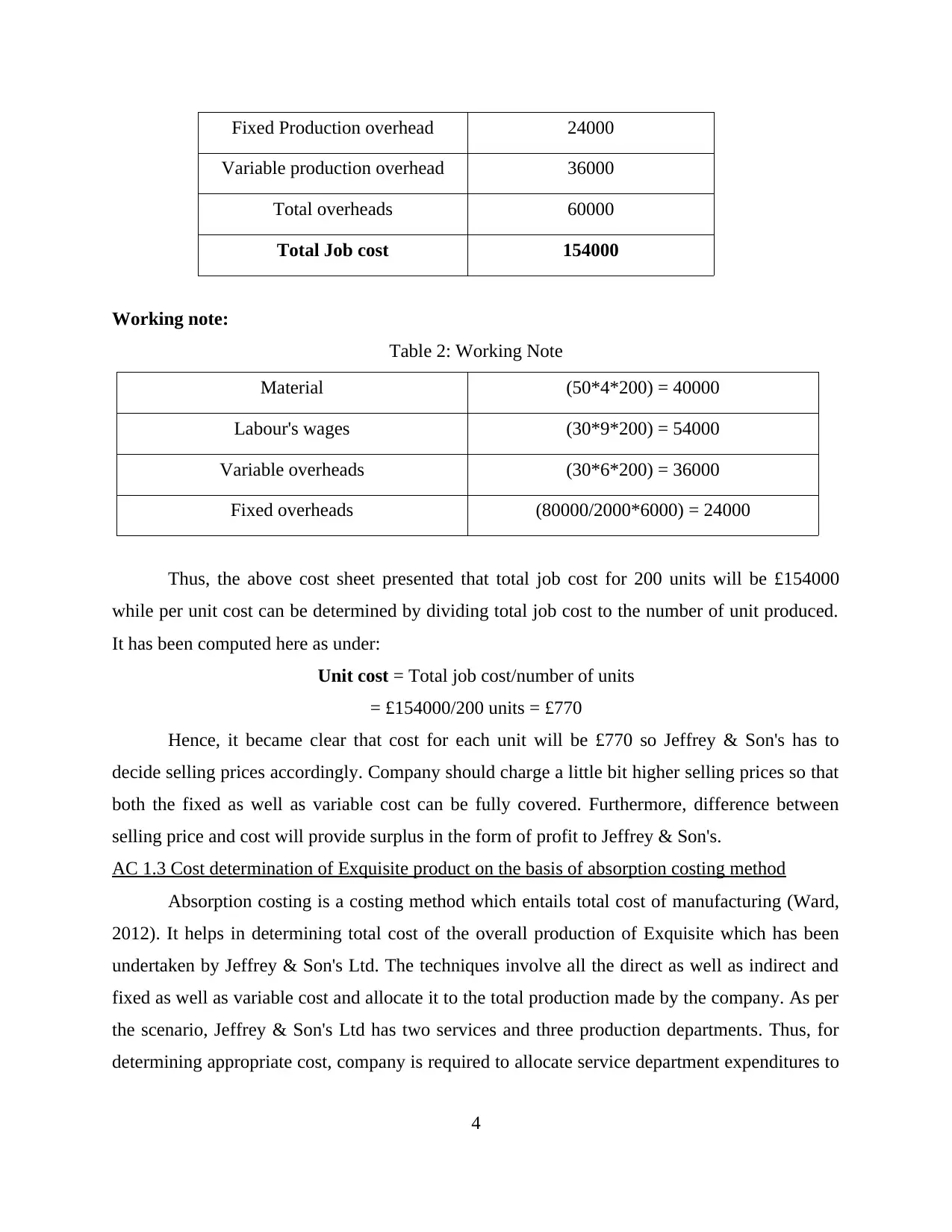
Fixed Production overhead 24000
Variable production overhead 36000
Total overheads 60000
Total Job cost 154000
Working note:
Table 2: Working Note
Material (50*4*200) = 40000
Labour's wages (30*9*200) = 54000
Variable overheads (30*6*200) = 36000
Fixed overheads (80000/2000*6000) = 24000
Thus, the above cost sheet presented that total job cost for 200 units will be £154000
while per unit cost can be determined by dividing total job cost to the number of unit produced.
It has been computed here as under:
Unit cost = Total job cost/number of units
= £154000/200 units = £770
Hence, it became clear that cost for each unit will be £770 so Jeffrey & Son's has to
decide selling prices accordingly. Company should charge a little bit higher selling prices so that
both the fixed as well as variable cost can be fully covered. Furthermore, difference between
selling price and cost will provide surplus in the form of profit to Jeffrey & Son's.
AC 1.3 Cost determination of Exquisite product on the basis of absorption costing method
Absorption costing is a costing method which entails total cost of manufacturing (Ward,
2012). It helps in determining total cost of the overall production of Exquisite which has been
undertaken by Jeffrey & Son's Ltd. The techniques involve all the direct as well as indirect and
fixed as well as variable cost and allocate it to the total production made by the company. As per
the scenario, Jeffrey & Son's Ltd has two services and three production departments. Thus, for
determining appropriate cost, company is required to allocate service department expenditures to
4
Variable production overhead 36000
Total overheads 60000
Total Job cost 154000
Working note:
Table 2: Working Note
Material (50*4*200) = 40000
Labour's wages (30*9*200) = 54000
Variable overheads (30*6*200) = 36000
Fixed overheads (80000/2000*6000) = 24000
Thus, the above cost sheet presented that total job cost for 200 units will be £154000
while per unit cost can be determined by dividing total job cost to the number of unit produced.
It has been computed here as under:
Unit cost = Total job cost/number of units
= £154000/200 units = £770
Hence, it became clear that cost for each unit will be £770 so Jeffrey & Son's has to
decide selling prices accordingly. Company should charge a little bit higher selling prices so that
both the fixed as well as variable cost can be fully covered. Furthermore, difference between
selling price and cost will provide surplus in the form of profit to Jeffrey & Son's.
AC 1.3 Cost determination of Exquisite product on the basis of absorption costing method
Absorption costing is a costing method which entails total cost of manufacturing (Ward,
2012). It helps in determining total cost of the overall production of Exquisite which has been
undertaken by Jeffrey & Son's Ltd. The techniques involve all the direct as well as indirect and
fixed as well as variable cost and allocate it to the total production made by the company. As per
the scenario, Jeffrey & Son's Ltd has two services and three production departments. Thus, for
determining appropriate cost, company is required to allocate service department expenditures to
4
⊘ This is a preview!⊘
Do you want full access?
Subscribe today to unlock all pages.

Trusted by 1+ million students worldwide
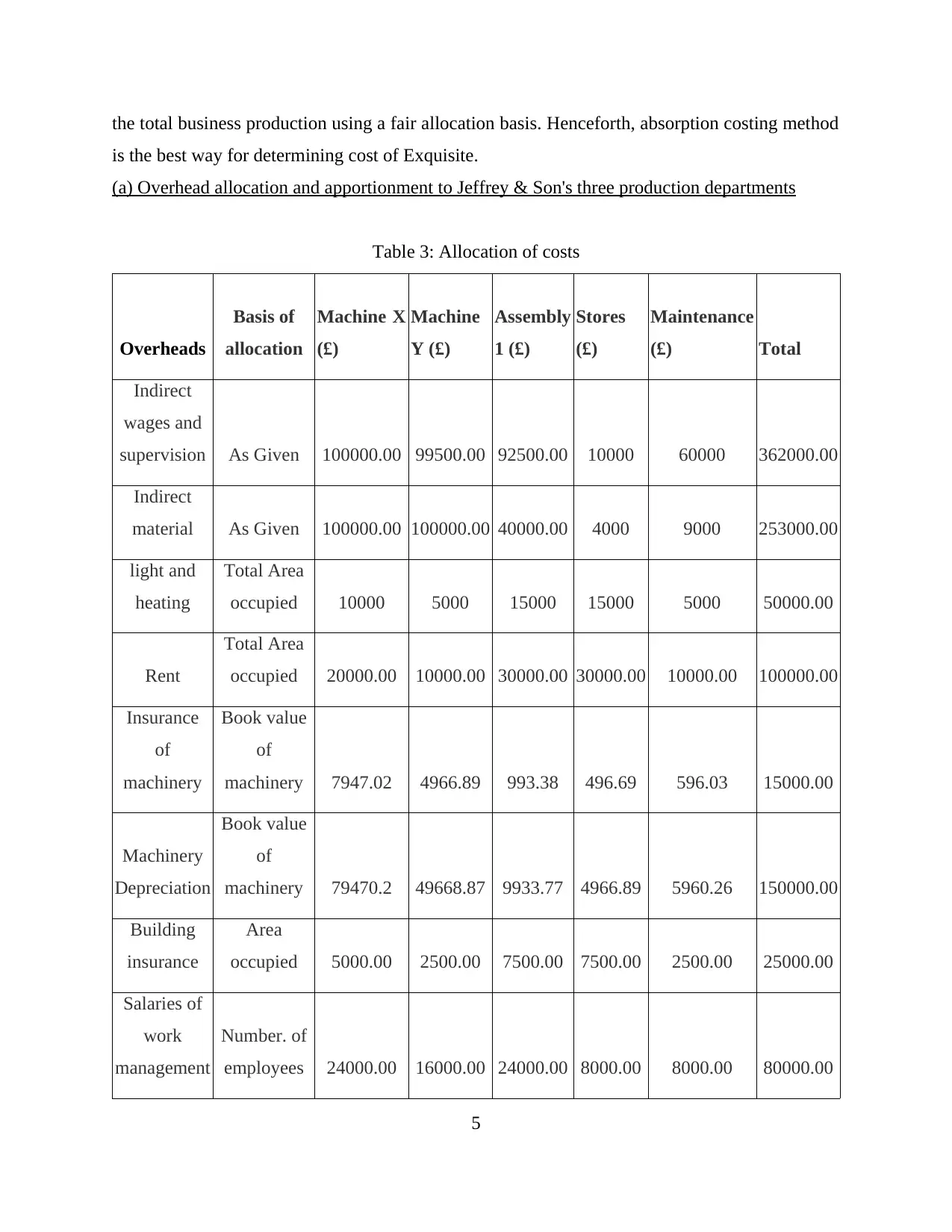
the total business production using a fair allocation basis. Henceforth, absorption costing method
is the best way for determining cost of Exquisite.
(a) Overhead allocation and apportionment to Jeffrey & Son's three production departments
Table 3: Allocation of costs
Overheads
Basis of
allocation
Machine X
(£)
Machine
Y (£)
Assembly
1 (£)
Stores
(£)
Maintenance
(£) Total
Indirect
wages and
supervision As Given 100000.00 99500.00 92500.00 10000 60000 362000.00
Indirect
material As Given 100000.00 100000.00 40000.00 4000 9000 253000.00
light and
heating
Total Area
occupied 10000 5000 15000 15000 5000 50000.00
Rent
Total Area
occupied 20000.00 10000.00 30000.00 30000.00 10000.00 100000.00
Insurance
of
machinery
Book value
of
machinery 7947.02 4966.89 993.38 496.69 596.03 15000.00
Machinery
Depreciation
Book value
of
machinery 79470.2 49668.87 9933.77 4966.89 5960.26 150000.00
Building
insurance
Area
occupied 5000.00 2500.00 7500.00 7500.00 2500.00 25000.00
Salaries of
work
management
Number. of
employees 24000.00 16000.00 24000.00 8000.00 8000.00 80000.00
5
is the best way for determining cost of Exquisite.
(a) Overhead allocation and apportionment to Jeffrey & Son's three production departments
Table 3: Allocation of costs
Overheads
Basis of
allocation
Machine X
(£)
Machine
Y (£)
Assembly
1 (£)
Stores
(£)
Maintenance
(£) Total
Indirect
wages and
supervision As Given 100000.00 99500.00 92500.00 10000 60000 362000.00
Indirect
material As Given 100000.00 100000.00 40000.00 4000 9000 253000.00
light and
heating
Total Area
occupied 10000 5000 15000 15000 5000 50000.00
Rent
Total Area
occupied 20000.00 10000.00 30000.00 30000.00 10000.00 100000.00
Insurance
of
machinery
Book value
of
machinery 7947.02 4966.89 993.38 496.69 596.03 15000.00
Machinery
Depreciation
Book value
of
machinery 79470.2 49668.87 9933.77 4966.89 5960.26 150000.00
Building
insurance
Area
occupied 5000.00 2500.00 7500.00 7500.00 2500.00 25000.00
Salaries of
work
management
Number. of
employees 24000.00 16000.00 24000.00 8000.00 8000.00 80000.00
5
Paraphrase This Document
Need a fresh take? Get an instant paraphrase of this document with our AI Paraphraser
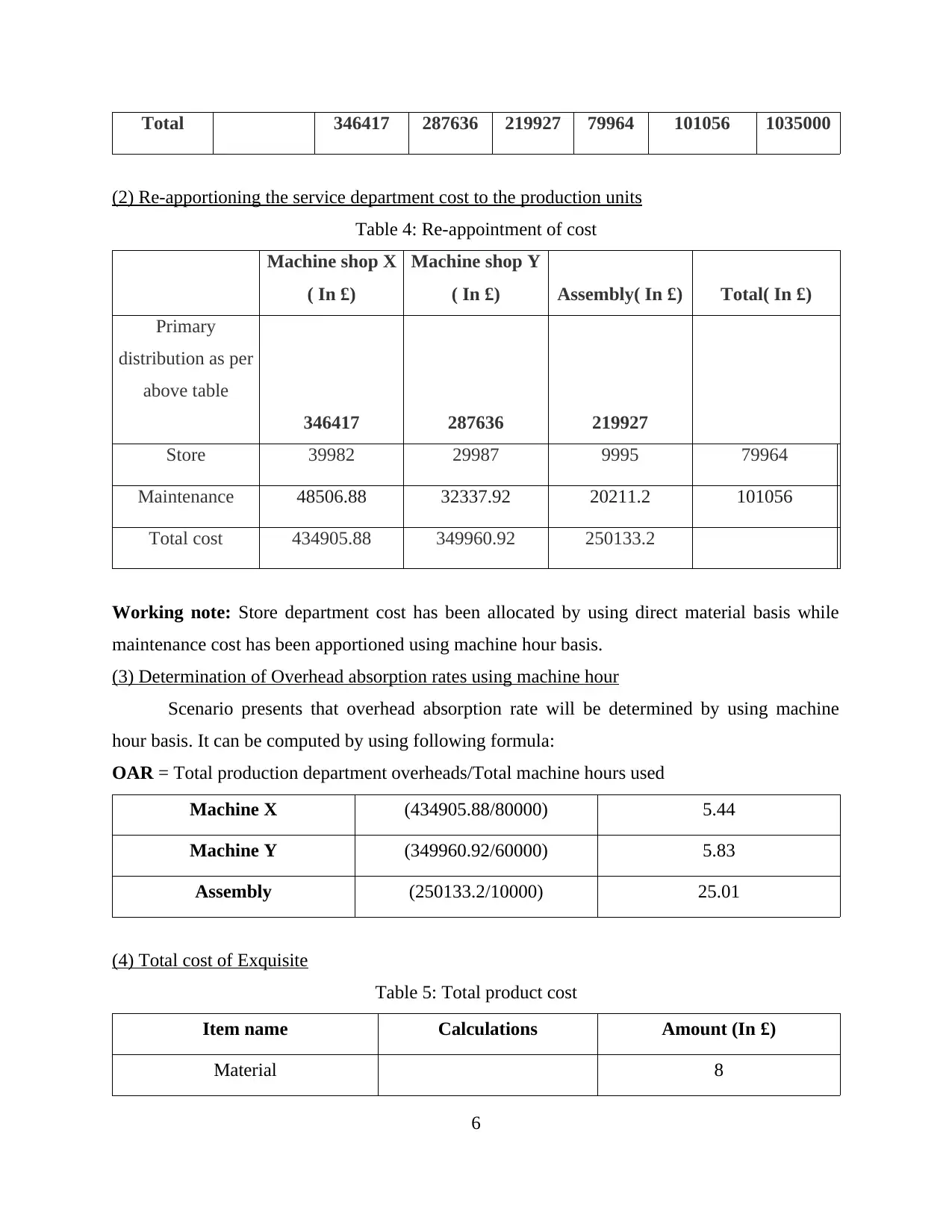
Total 346417 287636 219927 79964 101056 1035000
(2) Re-apportioning the service department cost to the production units
Table 4: Re-appointment of cost
Machine shop X
( In £)
Machine shop Y
( In £) Assembly( In £) Total( In £)
Primary
distribution as per
above table
346417 287636 219927
Store 39982 29987 9995 79964
Maintenance 48506.88 32337.92 20211.2 101056
Total cost 434905.88 349960.92 250133.2
Working note: Store department cost has been allocated by using direct material basis while
maintenance cost has been apportioned using machine hour basis.
(3) Determination of Overhead absorption rates using machine hour
Scenario presents that overhead absorption rate will be determined by using machine
hour basis. It can be computed by using following formula:
OAR = Total production department overheads/Total machine hours used
Machine X (434905.88/80000) 5.44
Machine Y (349960.92/60000) 5.83
Assembly (250133.2/10000) 25.01
(4) Total cost of Exquisite
Table 5: Total product cost
Item name Calculations Amount (In £)
Material 8
6
(2) Re-apportioning the service department cost to the production units
Table 4: Re-appointment of cost
Machine shop X
( In £)
Machine shop Y
( In £) Assembly( In £) Total( In £)
Primary
distribution as per
above table
346417 287636 219927
Store 39982 29987 9995 79964
Maintenance 48506.88 32337.92 20211.2 101056
Total cost 434905.88 349960.92 250133.2
Working note: Store department cost has been allocated by using direct material basis while
maintenance cost has been apportioned using machine hour basis.
(3) Determination of Overhead absorption rates using machine hour
Scenario presents that overhead absorption rate will be determined by using machine
hour basis. It can be computed by using following formula:
OAR = Total production department overheads/Total machine hours used
Machine X (434905.88/80000) 5.44
Machine Y (349960.92/60000) 5.83
Assembly (250133.2/10000) 25.01
(4) Total cost of Exquisite
Table 5: Total product cost
Item name Calculations Amount (In £)
Material 8
6
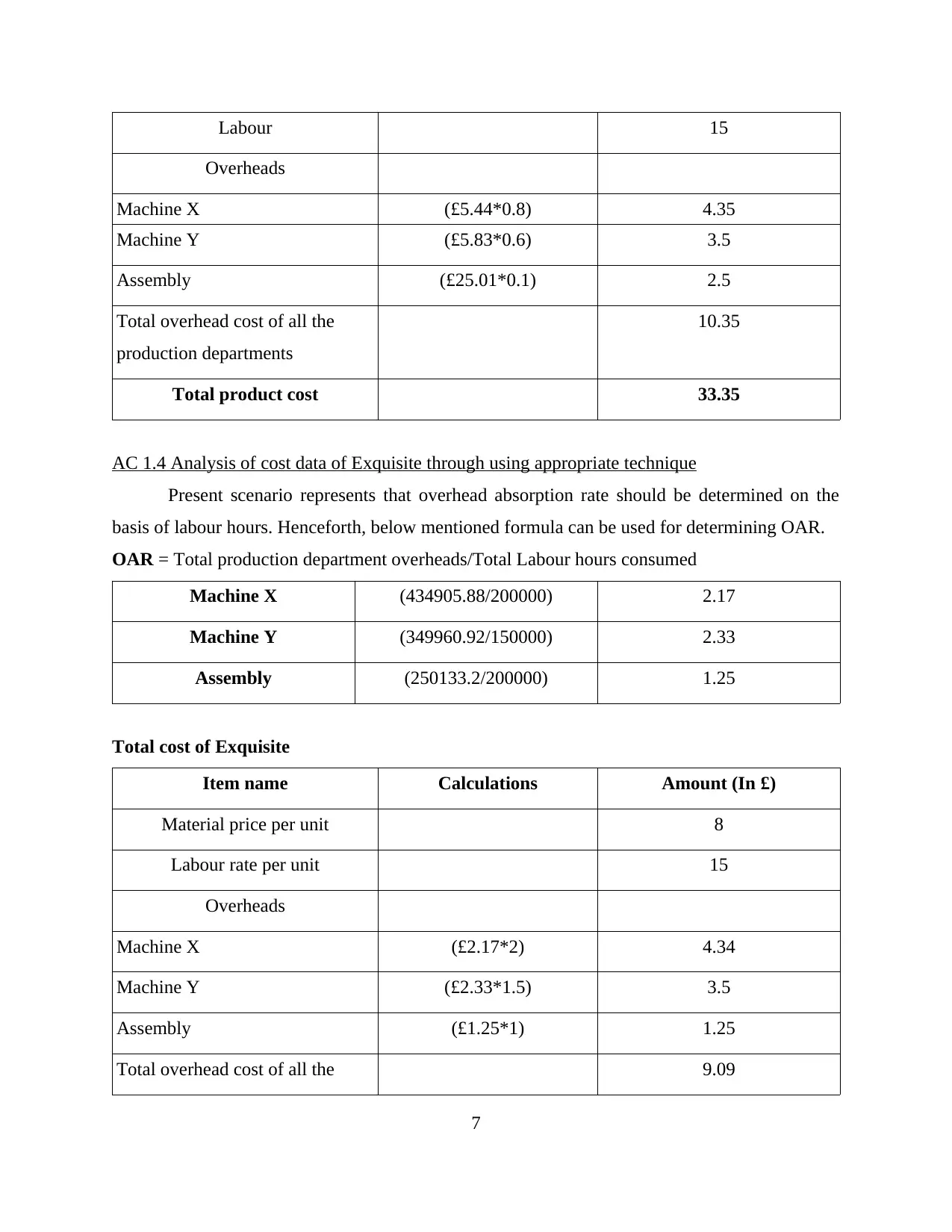
Labour 15
Overheads
Machine X (£5.44*0.8) 4.35
Machine Y (£5.83*0.6) 3.5
Assembly (£25.01*0.1) 2.5
Total overhead cost of all the
production departments
10.35
Total product cost 33.35
AC 1.4 Analysis of cost data of Exquisite through using appropriate technique
Present scenario represents that overhead absorption rate should be determined on the
basis of labour hours. Henceforth, below mentioned formula can be used for determining OAR.
OAR = Total production department overheads/Total Labour hours consumed
Machine X (434905.88/200000) 2.17
Machine Y (349960.92/150000) 2.33
Assembly (250133.2/200000) 1.25
Total cost of Exquisite
Item name Calculations Amount (In £)
Material price per unit 8
Labour rate per unit 15
Overheads
Machine X (£2.17*2) 4.34
Machine Y (£2.33*1.5) 3.5
Assembly (£1.25*1) 1.25
Total overhead cost of all the 9.09
7
Overheads
Machine X (£5.44*0.8) 4.35
Machine Y (£5.83*0.6) 3.5
Assembly (£25.01*0.1) 2.5
Total overhead cost of all the
production departments
10.35
Total product cost 33.35
AC 1.4 Analysis of cost data of Exquisite through using appropriate technique
Present scenario represents that overhead absorption rate should be determined on the
basis of labour hours. Henceforth, below mentioned formula can be used for determining OAR.
OAR = Total production department overheads/Total Labour hours consumed
Machine X (434905.88/200000) 2.17
Machine Y (349960.92/150000) 2.33
Assembly (250133.2/200000) 1.25
Total cost of Exquisite
Item name Calculations Amount (In £)
Material price per unit 8
Labour rate per unit 15
Overheads
Machine X (£2.17*2) 4.34
Machine Y (£2.33*1.5) 3.5
Assembly (£1.25*1) 1.25
Total overhead cost of all the 9.09
7
⊘ This is a preview!⊘
Do you want full access?
Subscribe today to unlock all pages.

Trusted by 1+ million students worldwide
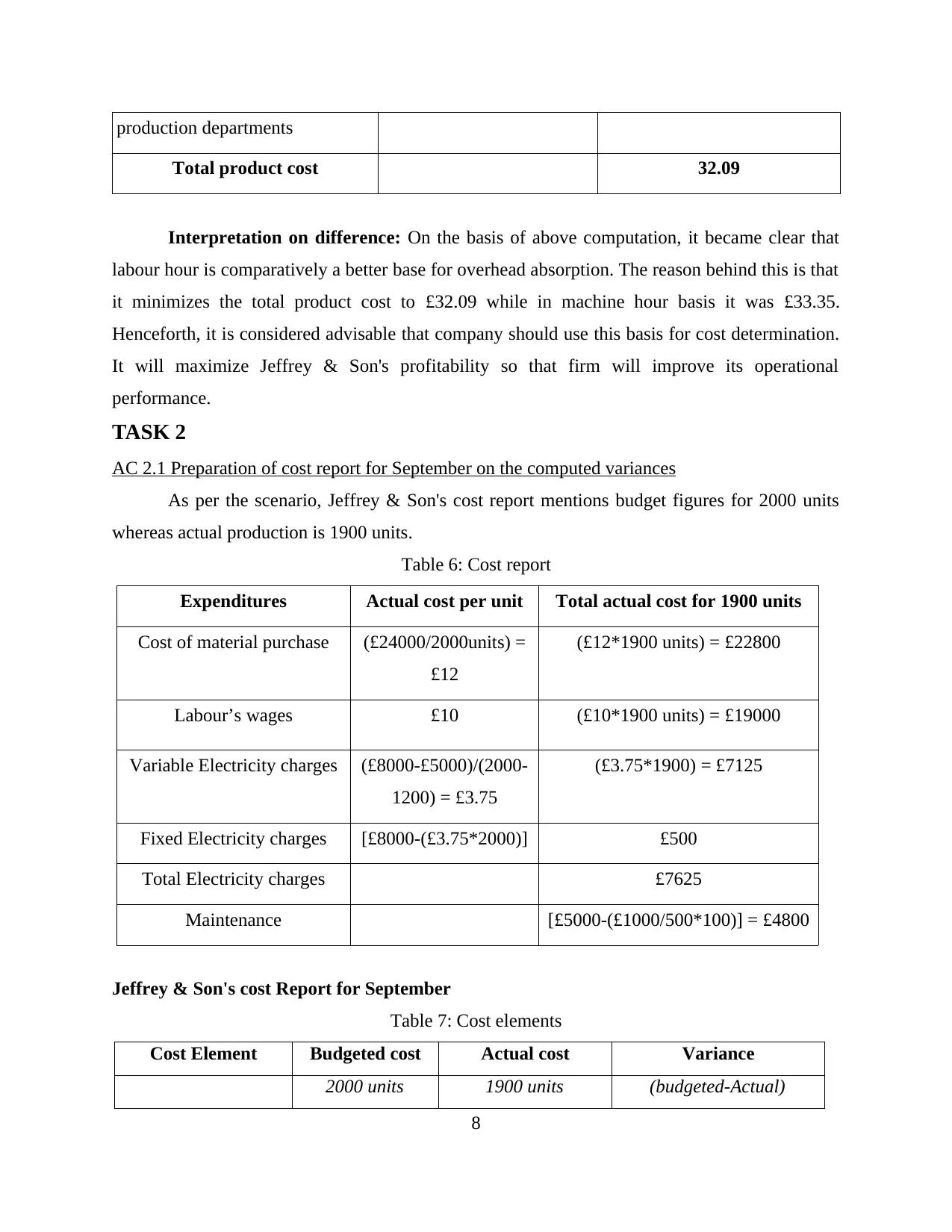
production departments
Total product cost 32.09
Interpretation on difference: On the basis of above computation, it became clear that
labour hour is comparatively a better base for overhead absorption. The reason behind this is that
it minimizes the total product cost to £32.09 while in machine hour basis it was £33.35.
Henceforth, it is considered advisable that company should use this basis for cost determination.
It will maximize Jeffrey & Son's profitability so that firm will improve its operational
performance.
TASK 2
AC 2.1 Preparation of cost report for September on the computed variances
As per the scenario, Jeffrey & Son's cost report mentions budget figures for 2000 units
whereas actual production is 1900 units.
Table 6: Cost report
Expenditures Actual cost per unit Total actual cost for 1900 units
Cost of material purchase (£24000/2000units) =
£12
(£12*1900 units) = £22800
Labour’s wages £10 (£10*1900 units) = £19000
Variable Electricity charges (£8000-£5000)/(2000-
1200) = £3.75
(£3.75*1900) = £7125
Fixed Electricity charges [£8000-(£3.75*2000)] £500
Total Electricity charges £7625
Maintenance [£5000-(£1000/500*100)] = £4800
Jeffrey & Son's cost Report for September
Table 7: Cost elements
Cost Element Budgeted cost Actual cost Variance
2000 units 1900 units (budgeted-Actual)
8
Total product cost 32.09
Interpretation on difference: On the basis of above computation, it became clear that
labour hour is comparatively a better base for overhead absorption. The reason behind this is that
it minimizes the total product cost to £32.09 while in machine hour basis it was £33.35.
Henceforth, it is considered advisable that company should use this basis for cost determination.
It will maximize Jeffrey & Son's profitability so that firm will improve its operational
performance.
TASK 2
AC 2.1 Preparation of cost report for September on the computed variances
As per the scenario, Jeffrey & Son's cost report mentions budget figures for 2000 units
whereas actual production is 1900 units.
Table 6: Cost report
Expenditures Actual cost per unit Total actual cost for 1900 units
Cost of material purchase (£24000/2000units) =
£12
(£12*1900 units) = £22800
Labour’s wages £10 (£10*1900 units) = £19000
Variable Electricity charges (£8000-£5000)/(2000-
1200) = £3.75
(£3.75*1900) = £7125
Fixed Electricity charges [£8000-(£3.75*2000)] £500
Total Electricity charges £7625
Maintenance [£5000-(£1000/500*100)] = £4800
Jeffrey & Son's cost Report for September
Table 7: Cost elements
Cost Element Budgeted cost Actual cost Variance
2000 units 1900 units (budgeted-Actual)
8
Paraphrase This Document
Need a fresh take? Get an instant paraphrase of this document with our AI Paraphraser
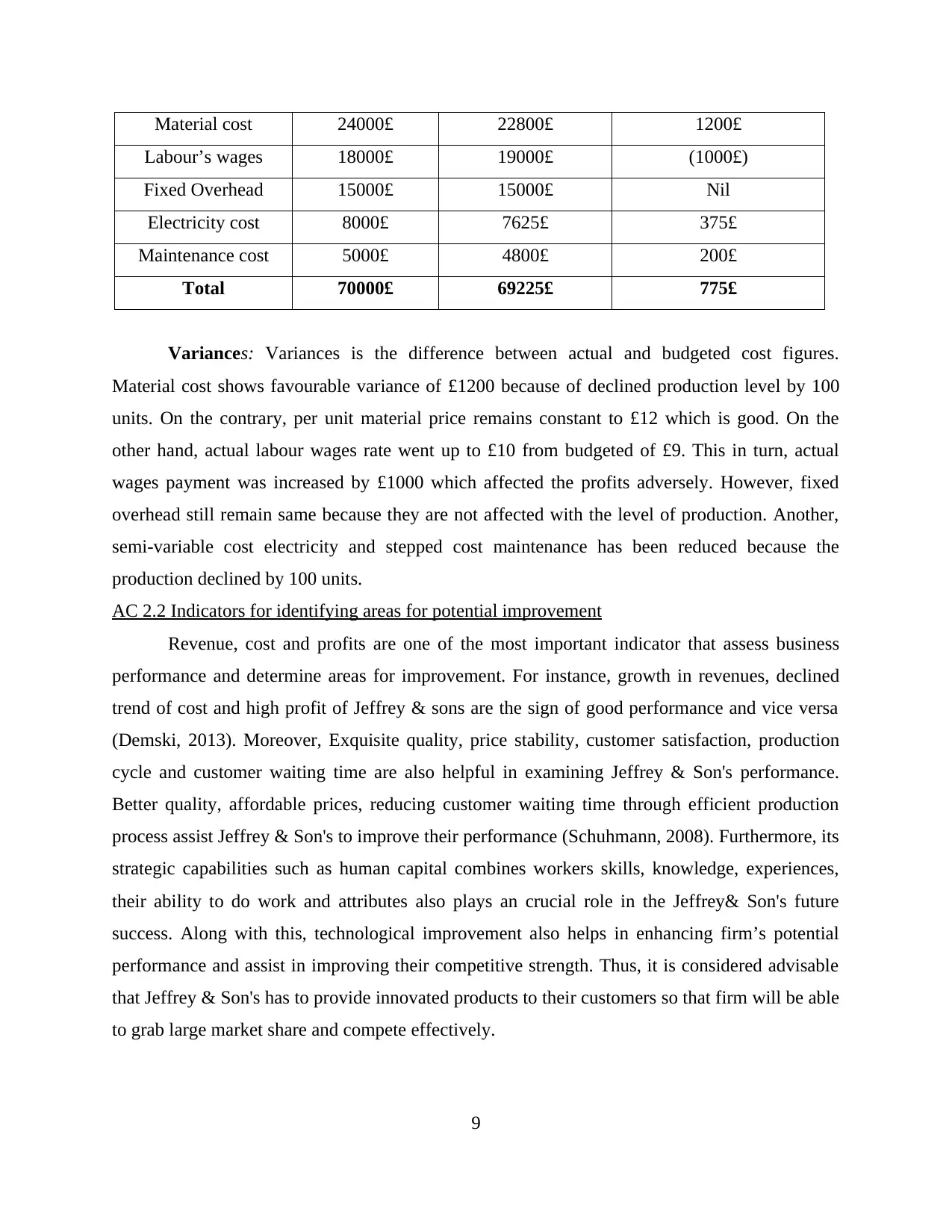
Material cost 24000£ 22800£ 1200£
Labour’s wages 18000£ 19000£ (1000£)
Fixed Overhead 15000£ 15000£ Nil
Electricity cost 8000£ 7625£ 375£
Maintenance cost 5000£ 4800£ 200£
Total 70000£ 69225£ 775£
Variances: Variances is the difference between actual and budgeted cost figures.
Material cost shows favourable variance of £1200 because of declined production level by 100
units. On the contrary, per unit material price remains constant to £12 which is good. On the
other hand, actual labour wages rate went up to £10 from budgeted of £9. This in turn, actual
wages payment was increased by £1000 which affected the profits adversely. However, fixed
overhead still remain same because they are not affected with the level of production. Another,
semi-variable cost electricity and stepped cost maintenance has been reduced because the
production declined by 100 units.
AC 2.2 Indicators for identifying areas for potential improvement
Revenue, cost and profits are one of the most important indicator that assess business
performance and determine areas for improvement. For instance, growth in revenues, declined
trend of cost and high profit of Jeffrey & sons are the sign of good performance and vice versa
(Demski, 2013). Moreover, Exquisite quality, price stability, customer satisfaction, production
cycle and customer waiting time are also helpful in examining Jeffrey & Son's performance.
Better quality, affordable prices, reducing customer waiting time through efficient production
process assist Jeffrey & Son's to improve their performance (Schuhmann, 2008). Furthermore, its
strategic capabilities such as human capital combines workers skills, knowledge, experiences,
their ability to do work and attributes also plays an crucial role in the Jeffrey& Son's future
success. Along with this, technological improvement also helps in enhancing firm’s potential
performance and assist in improving their competitive strength. Thus, it is considered advisable
that Jeffrey & Son's has to provide innovated products to their customers so that firm will be able
to grab large market share and compete effectively.
9
Labour’s wages 18000£ 19000£ (1000£)
Fixed Overhead 15000£ 15000£ Nil
Electricity cost 8000£ 7625£ 375£
Maintenance cost 5000£ 4800£ 200£
Total 70000£ 69225£ 775£
Variances: Variances is the difference between actual and budgeted cost figures.
Material cost shows favourable variance of £1200 because of declined production level by 100
units. On the contrary, per unit material price remains constant to £12 which is good. On the
other hand, actual labour wages rate went up to £10 from budgeted of £9. This in turn, actual
wages payment was increased by £1000 which affected the profits adversely. However, fixed
overhead still remain same because they are not affected with the level of production. Another,
semi-variable cost electricity and stepped cost maintenance has been reduced because the
production declined by 100 units.
AC 2.2 Indicators for identifying areas for potential improvement
Revenue, cost and profits are one of the most important indicator that assess business
performance and determine areas for improvement. For instance, growth in revenues, declined
trend of cost and high profit of Jeffrey & sons are the sign of good performance and vice versa
(Demski, 2013). Moreover, Exquisite quality, price stability, customer satisfaction, production
cycle and customer waiting time are also helpful in examining Jeffrey & Son's performance.
Better quality, affordable prices, reducing customer waiting time through efficient production
process assist Jeffrey & Son's to improve their performance (Schuhmann, 2008). Furthermore, its
strategic capabilities such as human capital combines workers skills, knowledge, experiences,
their ability to do work and attributes also plays an crucial role in the Jeffrey& Son's future
success. Along with this, technological improvement also helps in enhancing firm’s potential
performance and assist in improving their competitive strength. Thus, it is considered advisable
that Jeffrey & Son's has to provide innovated products to their customers so that firm will be able
to grab large market share and compete effectively.
9
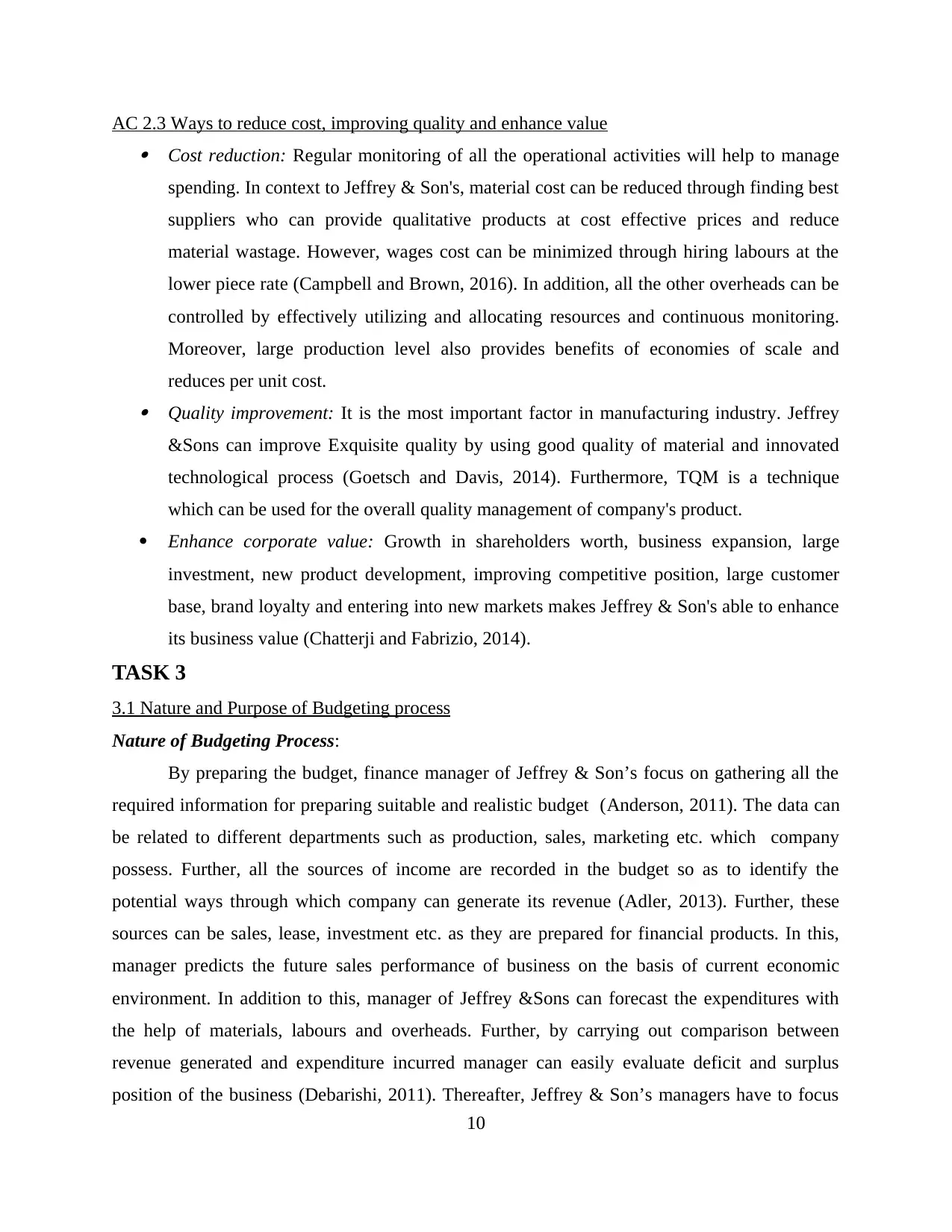
AC 2.3 Ways to reduce cost, improving quality and enhance value Cost reduction: Regular monitoring of all the operational activities will help to manage
spending. In context to Jeffrey & Son's, material cost can be reduced through finding best
suppliers who can provide qualitative products at cost effective prices and reduce
material wastage. However, wages cost can be minimized through hiring labours at the
lower piece rate (Campbell and Brown, 2016). In addition, all the other overheads can be
controlled by effectively utilizing and allocating resources and continuous monitoring.
Moreover, large production level also provides benefits of economies of scale and
reduces per unit cost. Quality improvement: It is the most important factor in manufacturing industry. Jeffrey
&Sons can improve Exquisite quality by using good quality of material and innovated
technological process (Goetsch and Davis, 2014). Furthermore, TQM is a technique
which can be used for the overall quality management of company's product.
Enhance corporate value: Growth in shareholders worth, business expansion, large
investment, new product development, improving competitive position, large customer
base, brand loyalty and entering into new markets makes Jeffrey & Son's able to enhance
its business value (Chatterji and Fabrizio, 2014).
TASK 3
3.1 Nature and Purpose of Budgeting process
Nature of Budgeting Process:
By preparing the budget, finance manager of Jeffrey & Son’s focus on gathering all the
required information for preparing suitable and realistic budget (Anderson, 2011). The data can
be related to different departments such as production, sales, marketing etc. which company
possess. Further, all the sources of income are recorded in the budget so as to identify the
potential ways through which company can generate its revenue (Adler, 2013). Further, these
sources can be sales, lease, investment etc. as they are prepared for financial products. In this,
manager predicts the future sales performance of business on the basis of current economic
environment. In addition to this, manager of Jeffrey &Sons can forecast the expenditures with
the help of materials, labours and overheads. Further, by carrying out comparison between
revenue generated and expenditure incurred manager can easily evaluate deficit and surplus
position of the business (Debarishi, 2011). Thereafter, Jeffrey & Son’s managers have to focus
10
spending. In context to Jeffrey & Son's, material cost can be reduced through finding best
suppliers who can provide qualitative products at cost effective prices and reduce
material wastage. However, wages cost can be minimized through hiring labours at the
lower piece rate (Campbell and Brown, 2016). In addition, all the other overheads can be
controlled by effectively utilizing and allocating resources and continuous monitoring.
Moreover, large production level also provides benefits of economies of scale and
reduces per unit cost. Quality improvement: It is the most important factor in manufacturing industry. Jeffrey
&Sons can improve Exquisite quality by using good quality of material and innovated
technological process (Goetsch and Davis, 2014). Furthermore, TQM is a technique
which can be used for the overall quality management of company's product.
Enhance corporate value: Growth in shareholders worth, business expansion, large
investment, new product development, improving competitive position, large customer
base, brand loyalty and entering into new markets makes Jeffrey & Son's able to enhance
its business value (Chatterji and Fabrizio, 2014).
TASK 3
3.1 Nature and Purpose of Budgeting process
Nature of Budgeting Process:
By preparing the budget, finance manager of Jeffrey & Son’s focus on gathering all the
required information for preparing suitable and realistic budget (Anderson, 2011). The data can
be related to different departments such as production, sales, marketing etc. which company
possess. Further, all the sources of income are recorded in the budget so as to identify the
potential ways through which company can generate its revenue (Adler, 2013). Further, these
sources can be sales, lease, investment etc. as they are prepared for financial products. In this,
manager predicts the future sales performance of business on the basis of current economic
environment. In addition to this, manager of Jeffrey &Sons can forecast the expenditures with
the help of materials, labours and overheads. Further, by carrying out comparison between
revenue generated and expenditure incurred manager can easily evaluate deficit and surplus
position of the business (Debarishi, 2011). Thereafter, Jeffrey & Son’s managers have to focus
10
⊘ This is a preview!⊘
Do you want full access?
Subscribe today to unlock all pages.

Trusted by 1+ million students worldwide
1 out of 20
Related Documents
Your All-in-One AI-Powered Toolkit for Academic Success.
+13062052269
info@desklib.com
Available 24*7 on WhatsApp / Email
![[object Object]](/_next/static/media/star-bottom.7253800d.svg)
Unlock your academic potential
Copyright © 2020–2025 A2Z Services. All Rights Reserved. Developed and managed by ZUCOL.





